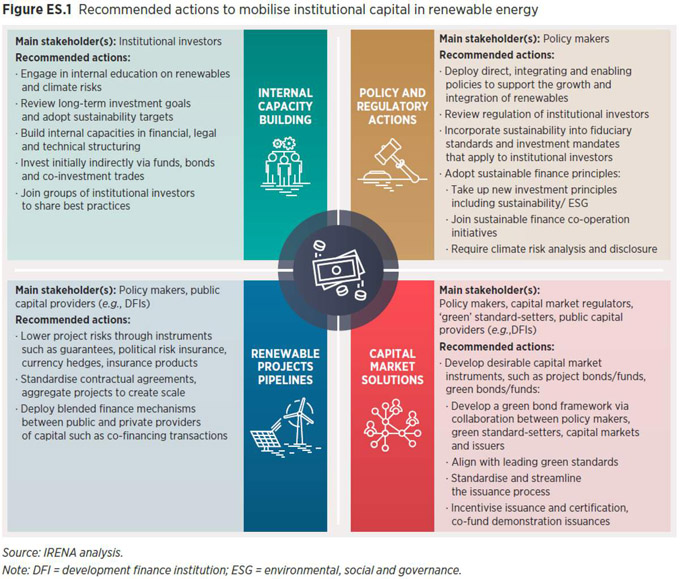The energy transformation is unstoppable. Renewable energy capacity additions have consistently outpaced the growth of traditional forms of energy over much of the last decade and in what has been dubbed the ‘decade of action’ the next 10 years are poised to be even more transformational. They will need to be.
To put the world on track to meeting Paris Climate and Sustainable Development Goals, the world needs to more than double the share of global energy supplied by renewables. By 2050, 65 per cent of total power should be renewable – a figure that rises from 26 per cent in 2019. An almost tripling of annual investment in renewables from around USD 300 billion per year to well over USD 800 billion per year will need to take place, with a total of USD 22.5 trillion invested in new renewable power capacity by 2050.
To achieve the acceleration necessary, all available sources of capital will need to be activated. And with institutional investors representing one of the largest capital pools--USD 100 trillion globally in securities, real property assets, insurance, pension funds and sovereign wealth funds--in the world, they are an indispensable part of the ongoing transition to a sustainable, low-carbon economy.
“Renewable energy assets provide institutional investors with relatively strong, stable, long-term ‘bond-like’ returns that match such investors’ long-term liabilities, while minimising the risk of stranded assets”
The International Renewable energy Agency’s (IRENA) report, “Mobilising Institutional Capital for Renewable Energy” (LINK), summarises the current state of institutional investment in renewables and provides actionable recommendations to scale them up. Institutional investment in renewables-focused funds is estimated at about USD 6 billion per year. Despite a growth in the number of direct renewable energy projects involving institutional investors, they represent only around 2 per cent of the total renewable project investments in 2018. This means that the potential of institutional capital in renewable energy remains largely underutilised.

Institutional assets are often managed very conservatively, especially in the case of emerging and developing markets. Renewable energy assets provide institutional investors with relatively strong, stable and long-term ‘bond-like’ returns that match such investors’ long-term liabilities, while minimising the risk of stranded assets. The figure above shows that institutional investors have strong preference in utility-scale solar PV and wind projects, due to the proven technologies and large transaction sizes.
With only 1% of the USD 87 trillion managed by over 5 800 institutional investors going directly to renewable energy projects in the past two decades, there is a lucrative and huge market gap that renewable energy could fill. This is particularly befitting with the current situation when the heightened unpredictability of oil investments returns make the business case for renewables even stronger. Not only can renewables meet institutional capital’s needs for more stable yields and better asset diversification, they can also meet the needs of a growing number of environmentally conscious investors and shareholders, who understand that countries need to achieve their climate goals with energy transformation.
Institutional investors new to renewable energy have the option to fund renewables through instruments that serve as alternatives to direct investments, such as infrastructure funds and green bonds. Evidence shows that such instruments, where available, are popular with investors new to the sector.
Now more than ever is the time to mobilise institutional capital for renewable energy projects to accelerate the energy transition. By channeling capital to #renewables, institutional investors can become a significant contributor to the global capital shift towards low-carbon solutions, while yielding higher returns in the longer term. Such a shift will, however, require combined efforts on multiple fronts with active engagement from all stakeholders; policy makers, institutional investors, public financiers, asset managers, and investors.

For more information, see IRENA’s Mobilising Institutional Capital for Renewable Energy.
KeyFacts Energy Industry Directory: IRENA
 KEYFACT Energy
KEYFACT Energy